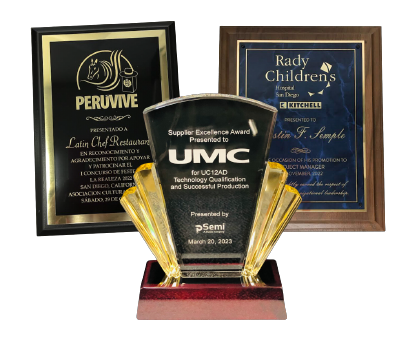Choosing the right words for a trophy plaque can feel overwhelming. The inscription becomes a permanent reminder of an achievement, so getting it right matters. Whether you’re recognizing an employee milestone, sports championship, or academic accomplishment, the text you choose should honor the recipient and capture the significance of their achievement.
Most trophy plaques include basic information: the recipient’s name, the award title, and the date. But the best inscriptions go beyond these basics. They tell a story, convey meaning, and make the recipient feel genuinely valued. The good news is that creating meaningful plaque text doesn’t require professional writing skills—just thoughtful consideration of what you want to communicate.
This guide covers everything you need to know about trophy plaque inscriptions, from essential elements to formatting considerations, helping you create text that recipients will treasure for years.
Essential Elements Every Trophy Plaque Should Include
Start with the fundamental information. Every plaque needs the recipient’s full name spelled correctly. Double-check the spelling—this is the most common mistake and the hardest to fix. Include their title or position if relevant to the award.
The award name or title comes next. Be specific about what’s being recognized. “Employee of the Year” is clear, but “Outstanding Leadership in Customer Service” tells a better story. The description should immediately communicate why this person received recognition.
Always include the date or time period. This could be a specific date, month and year, or academic year depending on your needs. Dates provide context and help recipients remember the circumstances of their achievement.
What to Include for Different Types of Awards
Recognition Awards
- Employee name and job title
- Specific achievement or quality being recognized
- Company name
- Presentation date
- Brief message of appreciation (optional)
Sports Trophies
- Team or individual name
- Championship title or tournament name
- Final score or record (if applicable)
- Season or competition date
- League or organization name
Corporate awards typically include company branding and may reference specific metrics or achievements. Academic awards should mention the institution, degree level, or specific subject area. Sports trophies often include team names, scores, and league information.
Crafting Meaningful Messages
The message portion separates memorable plaques from forgettable ones. Keep it concise but meaningful. A single powerful sentence often works better than multiple generic lines.
Consider the tone. Formal awards use traditional language, while team recognition can be more casual. Match the tone to your organization’s culture and the relationship with the recipient.
Personal touches make a difference. Reference specific accomplishments, qualities, or contributions. “For your dedication to our clients” resonates more than “For outstanding service.”
Formatting Tips for Professional-Looking Plaques
Text hierarchy guides the reader’s eye. The recipient’s name typically appears in the largest font. The award title comes next, followed by supporting details in smaller text. This creates a clear visual flow.
Center alignment works for most plaques, creating a traditional, balanced appearance. Left alignment can work for longer text blocks or modern designs. Avoid right alignment—it’s difficult to read.
Font selection affects readability and tone. Classic serif fonts like Times New Roman or Garatica convey formality. Sans-serif fonts like Arial or Helvetica feel modern. Script fonts work for signatures or accent text but avoid using them for body copy.
Line spacing prevents crowding. Text needs room to breathe. If your plaque looks cramped, reduce the text or increase the plaque size.
Understanding Space and Character Limits
Trophy plaques have physical limitations. A standard 7×9 inch plaque typically accommodates 4-6 lines of text comfortably. Smaller plaques hold less, while larger ones offer more flexibility.
Plan for approximately 30-40 characters per line on standard plaques, including spaces. Going beyond this forces smaller fonts that become difficult to read. When in doubt, less text is better than cramped text.
Consider the engraving method. Laser engraving allows for smaller text than traditional methods. Rotary engraving has minimum size requirements. At All Time Awards in San Diego, we can help you determine the optimal text amount for your specific plaque size and engraving method—contact us for personalized guidance on your award project.
Common Mistakes to Avoid
Spelling errors are permanent. Verify every name, title, and date multiple times. Have someone else proofread before finalizing your order.
Overcrowding the plaque is tempting when you have a lot to say. Resist this urge. White space makes text more readable and gives the plaque a professional appearance. If you need more text, consider a larger plaque.
Using too many fonts creates visual chaos. Stick to one or two complementary fonts maximum. Let size and weight (bold, italic) create hierarchy rather than switching between multiple typefaces.
Inconsistent capitalization looks unprofessional. Decide on title case, sentence case, or all caps and stick with it throughout the inscription.
Examples of Effective Trophy Inscriptions
A sales award might read: “Sarah Johnson / Top Sales Performer / $2.5 Million in Revenue / 2025 / XYZ Corporation”
A retirement plaque could say: “Michael Chen / In Recognition of 30 Years of Dedicated Service / 1995 – 2025 / Your Leadership and Mentorship Have Shaped Our Team”
A sports trophy might state: “Central High School Basketball / Division Champions / 24-2 Record / 2024-2025 Season”
Academic recognition could include: “Jennifer Martinez / Outstanding Achievement in Marine Biology / Dean’s Research Award / Spring 2025”
Final Considerations
Review your inscription in context. How will it look on the trophy base or plaque? Request a proof before production begins. Most companies provide digital mockups showing exactly how your text will appear.
Think long-term. Will this inscription make sense in five or ten years? Avoid trendy phrases or references that might not age well.
Remember that the best trophy inscriptions balance information with emotion. They document the achievement while conveying genuine appreciation for the recipient’s efforts.


